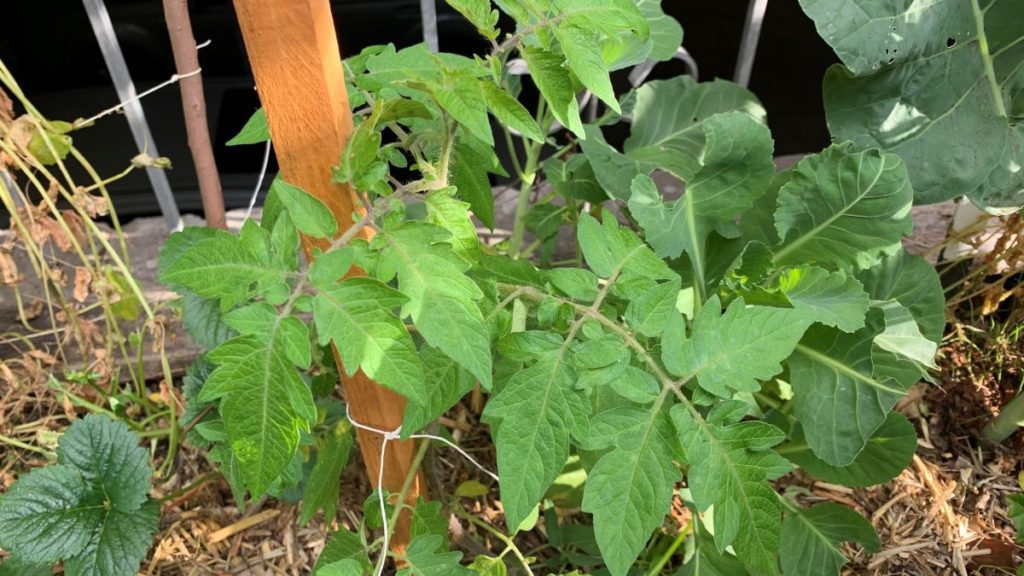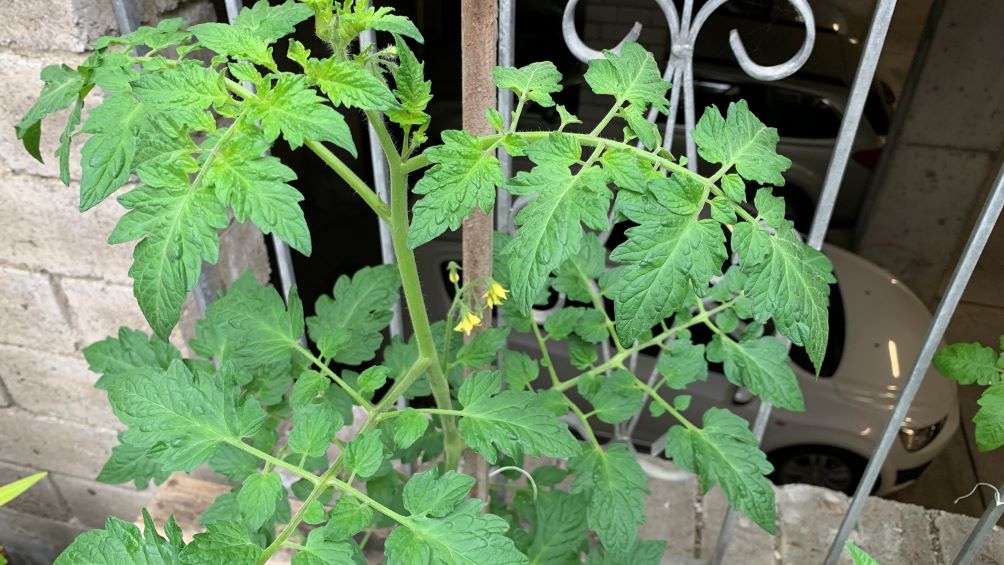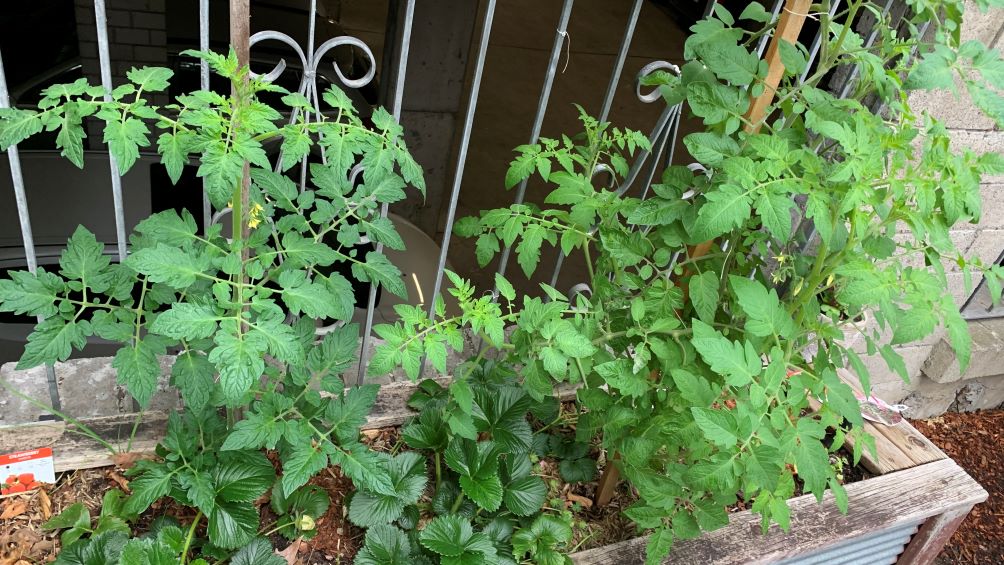Staking tomatoes in raised beds will help to keep the tomato upright giving each plant space to grow and for the flowers to be pollinated. Staking tomatoes is essential in raised beds to keep them from touching the ground and branching out into the space of the other plants.
This article will explore how to stake tomatoes in raised beds to grow more flowers and tomatoes over summer.

How to stake tomatoes in raised beds
These are my top tips for successfully staking tomatoes in raised beds to keep them upright, supported and allowing them the room to grow flowers and fruit.
Choose the best sized stakes
Choosing the right sized stake is important to support your tomatoes. A 6 foot stake will be perfect for most tomato plants and allow you to grow them tall for more tomatoes.
Remember that the stake will go in the ground at least 1 foot deep so remember this when you are choosing your stake size. You can use smaller stakes for bush tomatoes like Roma and cherry and keep them pruned to around 4 feet.
Larger tomatoes like beefsteak and Grosse Lisse can grow over 8 feet tall so choose the tallest stake you can find. There are many options that include recycled plastic, hardwood or bamboo. Hardwood and recycled plastic form a strong stake that can last for years.
If you choose a bamboo stake, choose a wide piece to make sure it is strong enough to hold the weight of your tomato plant.

Push stakes into the soil at least 1 foot
It is important to push all stakes, no matter what their length into the soil around 1 foot. This will keep the stake stable enough to hold the weight of the tomato plant when it is fully grown.
Use a hammer or mallet to push the stake into the ground and make sure you are wearing garden gloves. Hardwood stakes can splinter easily so take care when you are holding and hitting the stakes into the ground.
To make it easier to know how far the stake is in the ground, tie a small piece of string 1 foot up from the base so you know when to stop pushing the stake into the ground.

Tying tomatoes to the stakes
The next step is to tie the tomatoes to the stakes. Place the stake a few inches away from the base of the tomato plant so it is easy to reach the stem. Put the stake in the ground straight after planting so that you don’t damage the tomato roots once the plant has established.
There are lots of options when tying tomatoes to the stake. The best option are old pantyhose because they are soft and stretchy. Cut pieces that are long enough to reach around the whole stem with plenty of room to tie a knot.
You can also use pre-made plant ties or even kitchen string. Stretchy, soft ties are best as they will limit the damage to the stem when the plant moves. String that doesn’t stretch may need to be removed as the plant grows and replaced with a longer piece so it doesn’t cut into the stem.
Staking determinant and indeterminant tomatoes
It is important to know that tomatoes come in two main types, determinant and indeterminant. Determinant tomatoes will grow to a maximum size then grow their flowers and fruit in a short period of time.
Determinant tomatoes are also known as bush tomatoes and include types of cherry tomatoes and Romas. These will grow more branches and will usually grow to a maximum size of 6 feet. These can benefit from a tomato cage as they will generally be bushy with smaller branches.
Indeterminant tomatoes will grow as a long vine. They will grow flowers up the stem as it grows and continue to grow taller over the season. These tomatoes tend to produce fruit for a longer period of time. They grow best when tied to a single stake as more ties can be added higher up as they grow.
Is it better to stake or cage tomatoes?
It is better to stake tall, larger growing tomatoes like beefsteak, gross lisse and brandywine. Most large varieties of tomato will grow on indeterminant vines which can be tied to a tall stake. Rather than growing side shoots, these tomatoes will produce large fruit from flowers growing from the main stem.
Tomato cages work well for bush varieties including cherry tomatoes. These plants will grow side stems which can produce lots of small fruit. Tomato cages are perfect for a large harvest of small tomatoes and means you will not need to tie the plant.
At what height should you stake tomatoes?
It is best to place your tomato stake in the ground as soon as you plant them. This means that you are less likely to damage the roots compared to adding the stake once it has started growing.
I always plant my tomato seedlings and then hit my stake in a few inches away from the stem. This makes it easy to tie as the plant grows.
You will generally need to start tying your tomato to the stake as soon as it reaches around 6 or 7 inches. This is when it can start to flop over if it gets too tall.
Staking tomatoes in raised beds | Summary
Staking tomatoes in raised beds is an important step to keep them upright, off the ground, off of each other to grow lots of flowers and fruit. All tomatoes will need staking with either a hardwood, bamboo, recycled plastic stake or tomato cage.
Use a tomato cage to make it keep bush tomatoes upright and opt for a single stake for large, vine tomatoes.
Happy growing.
Tomatoes
- Will tomatoes grow in 4 hours of sun? | Tips for success
- Will tomato seedlings recover from sunscald? | 4 Ways to know
- Will tomato seedlings recover from sunscald? | 4 Ways to know
- Mulching tomato plants with newspaper | 6 Easy Steps
- Tomato seedlings not growing | 7 Top Causes and Cures
- How to keep mice off tomato plants | Top 7 extraordinary solutions
- How to grow Beefsteak Tomatoes
- Tomato seedlings turning yellow | 8 Reasons and easy solutions
- Leggy Tomato Seedlings | How to solve this problem
- Tomato Sprouts Wilting | Causes + How to Fix it
I am an accredited practicing dietitian, experienced gardener and a dedicated cook. I love writing and sharing my experience so you can learn from my successes and mistakes.
